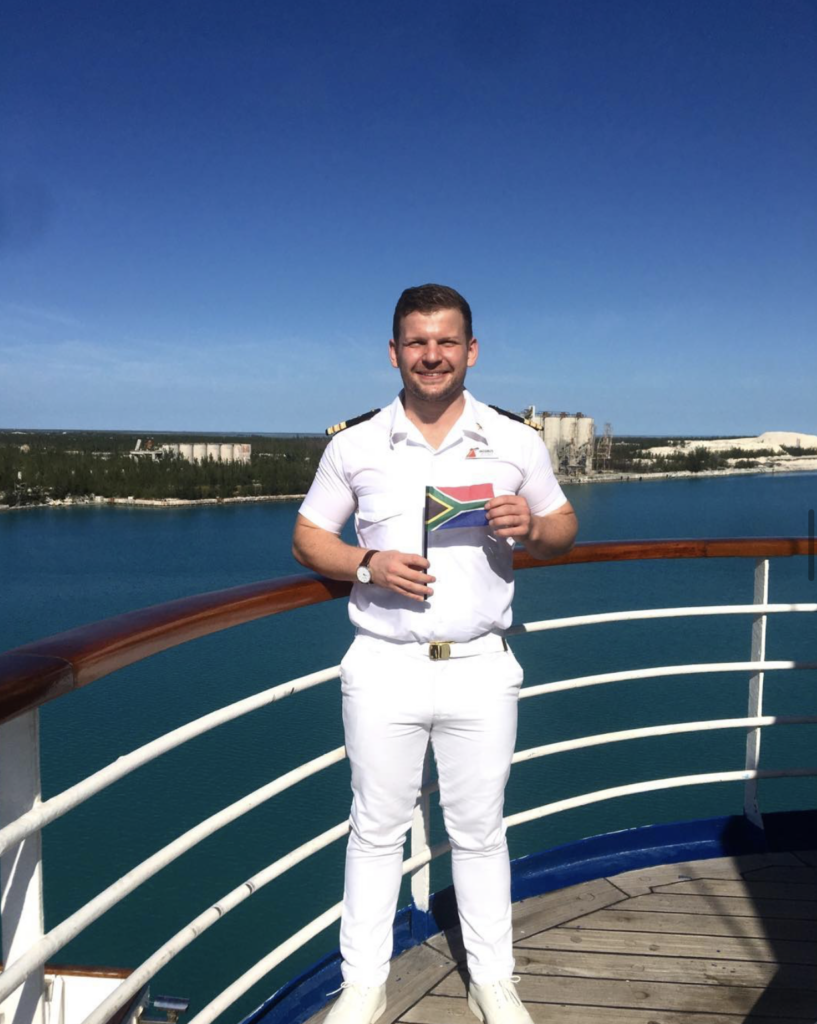You look at your watch, it is 15:10 EST as you make your way for a last quick dip in the warm Bahamian waters. Drifting on your back with the blue skies above you, saltwater in your hair and the smell of American beef patties on the grill floating through the air, you catch yourself thinking, “Am I really getting paid for this?”.
Little did I know that this would be the case when I graced the States with my ‘boere tan’ and Havaiana flip-flops. A lonely soul on the dock in Jacksonville Florida with my little backpack and a croissant I had just sneaked out of my hotel, about to board my first cruise ship as a doctor. For South Africans our references for cruise holidays point to little more than that one on Bok-radio and maybe a matric rage cruise, both being potentially lethal options. Globally, however, cruises have been the fastest-growing tourism sector, with 2020 poised to be a record-breaking year. Once you are on the ships you can understand why.
The consensus that they are floating hotels is an understatement of note. These ships have it all; bars, swimming pools, rollercoasters, waterparks, multiple restaurants, five-star suites, casinos, rock climbing walls, trapeze artists, dance shows and 24-hour service to the guests. All this and you haven’t even left the port yet!
Destinations on the itinerary vary, with routes in the Bahamas, Mexico, the Mediterranean, Baltic, Antarctic, East Coast, West Coast, Singapore and Hawaii. You can travel to just about anywhere in the world where water touches the shore. Generally, the ship will port at a particular destination for a day and guests will get out and explore, returning to the ship in the afternoon to sail onto the next stop. Depending on your company, you may end up on a World Cruise for one contract and a Bahamas cruise for the next. With increased seniority at your company, you may be able to request certain routes. This is an ideal situation if you seek to travel and enrich yourself with different cultures.
Another benefit of your senior rank, reached after six months of working for the company, is that you may be allowed to bring a partner on board with you, making it an exciting way for couples to see the world together.
The cruise ships vary in size ranging from 400 guests to some of the newer mega-ships where the number of guests may reach almost 7000. This excludes the crew onboard, consisting of between 800 and 1800 members. The medical team is normally made up of two doctors, and three to five nurses, depending on the size of the ship, with paramedics included on some of the larger ships. Medical centres on board the majority of ships need to be accredited to ICU standards of American hospitals. This means that your facilities are not as limited as you may expect, being out at sea. Ventilating capabilities, resuscitation rooms, emergency and general drug stocks, X-ray machines and basic laboratory tests are all available for your use. In terms of working hours, depending on the number of doctors on board, you will split the on-call after hour duties for alternate days. However, in emergency situations, it is expected of the whole medical team to respond. Clinics generally run for three hours in the morning and three hours in the afternoon, where you attend to the guests and crew.
Social time on the ship is unique because you have cultures from all over the world interacting and sharing spaces. As a doctor, you are automatically a senior officer on board the ship.
This has numerous benefits which include using guest areas such as restaurants, pools and bars, being able to watch shows or movies, coffee privileges, eating with the Captain etc. Other facilities available to you are a gym, outside running track, TV in your room, a crew bar and if you want to treat yourself, you can even go to the spa.

Basic contract details:
Contract length: 4-5 months
Time between contracts: 2 months (for most companies this will be unpaid)
Average pay: Depends on the company and contract structure. Some companies are commission-based, others will have a fixed daily rate (tax-free).
Cabins: Single occupancy (senior doctors may be assigned a suite)
Food: Included
Courses and travel expenses: Covered by the company
My advice on how to become a cruise ship doctor:
1- Do your courses: BLS, ACLS, PALS, ATLS (Basic EM Ultrasound courses are increasingly becoming a requirement for more companies)
2- Diploma in Emergency Care (DipEC) or Diploma in Anaesthetics (DA)
3- Contact a recruiting firm.
4- The rest of the process includes an initial clearance and then subsequent interviews ranging from those with HR representatives to medical interviews.
5- Once you have received an employment offer, you can start your Visa application.
My advice would be to book your ATLS as soon as possible as this does seem to be a hindering factor for a lot of candidates. I would say that any private GP or ER experience before starting the process of applying to work on cruise ships will be of benefit to you, but it is not a necessity.
Once you have accepted your job offer, make sure to get in touch with a tax specialist who specialises in maritime tax. This is important as the tax-free benefit of working abroad makes a big difference to your salary and there are certain criteria that you need to meet in order to qualify.
The pandemic has frozen the cruising industry as a whole and it is difficult to predict exactly how it will look in the future. From where I sit though, it looks promising. My recommendation is that you use this opportunity as a stepping stone to study further, learn a new language; or just take some time away from the norm and have a well-deserved moment to escape the ‘rat race’.
If you are considering a career at sea or if you are wondering whether this is for you, go for it! At the very least you will see interesting places, experience a new world and make a few dollars. At worst, people will judge you at Wimpy when you ask for a burger and fries in an American accent.

